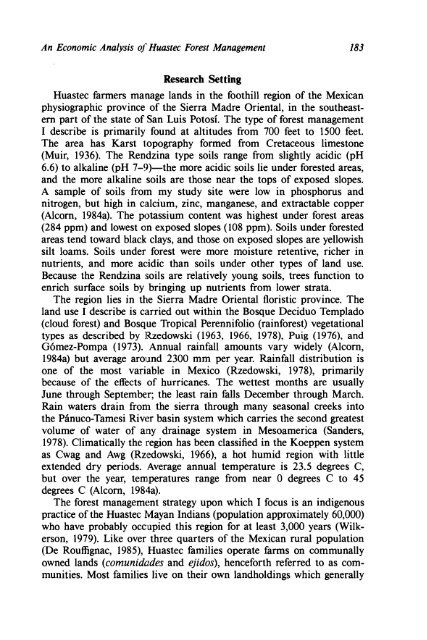Fragile Lands of Latin America Strategies for ... - PART - USAID
Fragile Lands of Latin America Strategies for ... - PART - USAID
Fragile Lands of Latin America Strategies for ... - PART - USAID
Create successful ePaper yourself
Turn your PDF publications into a flip-book with our unique Google optimized e-Paper software.
An Economic Analysis oj- Huastec Forest Management<br />
Research Setting<br />
Huastec farmers manage lands in the foothill region <strong>of</strong> the Mexican<br />
physiographic province <strong>of</strong> the Sierra Madre Oriental, in the southeast-<br />
em part <strong>of</strong> the state <strong>of</strong> San Luis Potosi. The type <strong>of</strong> <strong>for</strong>est management<br />
I describe is primarily found at altitudes from 700 feet to 1500 feet.<br />
The area has Karst 1.opography <strong>for</strong>med from Cretaceous limestone<br />
(Muir, 1936). The Rendzina type soils range from slighlly acidic (pH<br />
6.6) to alkaline (pH 7-!))-the more acidic soils lie under <strong>for</strong>ested areas,<br />
and the more alkaline soils are those near the tops <strong>of</strong> exposed slopes.<br />
A sample <strong>of</strong> soils from my study site were low in phosphorus and<br />
nitrogen, but high in calcium, zinc, manganese, and extractable copper<br />
(Alcom, 1984a). The potassium content was highest under <strong>for</strong>est areas<br />
(284 ppm) and lowest on exposed slopes (108 ppm). Soils under <strong>for</strong>ested<br />
areas tend toward black clays, and those on exposed slopes are yellowish<br />
silt loams. Soils under <strong>for</strong>est were more moisture retentive, richer in<br />
nutrients, and more acidic than soils under other types <strong>of</strong> land use.<br />
Because the Rendzina soils are relatively young soils, trees function to<br />
enrich surface soils by bringing up nutrients from lower strata.<br />
The region lies in the Sierra Madre Oriental floristic province. The<br />
land use I describe is carried out within the Bosque Deciduo Templado<br />
(cloud <strong>for</strong>est) and Bosque Tropical Perennifolio (rain<strong>for</strong>est) vegetational<br />
types as described by lRzedowski (1963, 1966, 1978), Puig (1976), and<br />
G6mez-Pompa (1973). Annual rainfall amounts vary widely (Alcorn,<br />
1984a) but average around 2300 mm per year. Rainfall distribution is<br />
one <strong>of</strong> the most variable in Mexico (Rzedowski, 1978), primarily<br />
because <strong>of</strong> the effects <strong>of</strong> hurricanes. The wettest months are usually<br />
June through September; the least rain falls December through March.<br />
Rain waters drain from the sierra through many seasonal creeks into<br />
the Phnuco-Tamesi River basin system which carries the second greatest<br />
volume <strong>of</strong> water <strong>of</strong> any drainage system in Mesoamerica (Sanders,<br />
1978). Climatically the region has been classified in the Koeppen system<br />
as Cwag and Awg (Rzledowski, 1966), a hot humid region with little<br />
extended dry periods. Average annual temperature is 23.5 degrees C,<br />
but over the year, ternlperatures range from near 0 degrees C to 45<br />
degrees C (Alcorn, 1984a).<br />
The <strong>for</strong>est management strategy upon which I focus is an indigenous<br />
practice <strong>of</strong> the Huastec Mayan Indians (population approximately 60,000)<br />
who have probably occlupied this region <strong>for</strong> at least 3,000 years (Wilk-<br />
erson, 1979). Like over three quarters <strong>of</strong> the Mexican rural population<br />
(De Rouffignac, 1985), Huastec families operate farms on communally<br />
owned lands (comunidades and ejidos), hence<strong>for</strong>th referred to as com-<br />
munities. Most families live on their own landholdings which generally

















